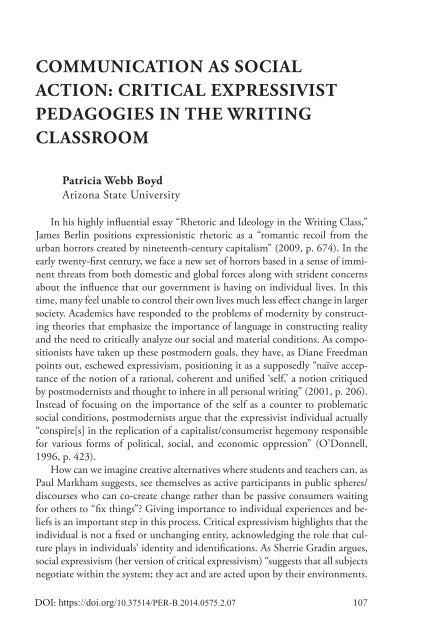Critical Expressivism- Theory and Practice in the Composition Classroom, 2014a
Critical Expressivism- Theory and Practice in the Composition Classroom, 2014a
Critical Expressivism- Theory and Practice in the Composition Classroom, 2014a
Create successful ePaper yourself
Turn your PDF publications into a flip-book with our unique Google optimized e-Paper software.
COMMUNICATION AS SOCIAL<br />
ACTION: CRITICAL EXPRESSIVIST<br />
PEDAGOGIES IN THE WRITING<br />
CLASSROOM<br />
Patricia Webb Boyd<br />
Arizona State University<br />
In his highly <strong>in</strong>fluential essay “Rhetoric <strong>and</strong> Ideology <strong>in</strong> <strong>the</strong> Writ<strong>in</strong>g Class,”<br />
James Berl<strong>in</strong> positions expressionistic rhetoric as a “romantic recoil from <strong>the</strong><br />
urban horrors created by n<strong>in</strong>eteenth-century capitalism” (2009, p. 674). In <strong>the</strong><br />
early twenty-first century, we face a new set of horrors based <strong>in</strong> a sense of imm<strong>in</strong>ent<br />
threats from both domestic <strong>and</strong> global forces along with strident concerns<br />
about <strong>the</strong> <strong>in</strong>fluence that our government is hav<strong>in</strong>g on <strong>in</strong>dividual lives. In this<br />
time, many feel unable to control <strong>the</strong>ir own lives much less effect change <strong>in</strong> larger<br />
society. Academics have responded to <strong>the</strong> problems of modernity by construct<strong>in</strong>g<br />
<strong>the</strong>ories that emphasize <strong>the</strong> importance of language <strong>in</strong> construct<strong>in</strong>g reality<br />
<strong>and</strong> <strong>the</strong> need to critically analyze our social <strong>and</strong> material conditions. As compositionists<br />
have taken up <strong>the</strong>se postmodern goals, <strong>the</strong>y have, as Diane Freedman<br />
po<strong>in</strong>ts out, eschewed expressivism, position<strong>in</strong>g it as a supposedly “naïve acceptance<br />
of <strong>the</strong> notion of a rational, coherent <strong>and</strong> unified ‘self,’ a notion critiqued<br />
by postmodernists <strong>and</strong> thought to <strong>in</strong>here <strong>in</strong> all personal writ<strong>in</strong>g” (2001, p. 206).<br />
Instead of focus<strong>in</strong>g on <strong>the</strong> importance of <strong>the</strong> self as a counter to problematic<br />
social conditions, postmodernists argue that <strong>the</strong> expressivist <strong>in</strong>dividual actually<br />
“conspire[s] <strong>in</strong> <strong>the</strong> replication of a capitalist/consumerist hegemony responsible<br />
for various forms of political, social, <strong>and</strong> economic oppression” (O’Donnell,<br />
1996, p. 423).<br />
How can we imag<strong>in</strong>e creative alternatives where students <strong>and</strong> teachers can, as<br />
Paul Markham suggests, see <strong>the</strong>mselves as active participants <strong>in</strong> public spheres/<br />
discourses who can co-create change ra<strong>the</strong>r than be passive consumers wait<strong>in</strong>g<br />
for o<strong>the</strong>rs to “fix th<strong>in</strong>gs”? Giv<strong>in</strong>g importance to <strong>in</strong>dividual experiences <strong>and</strong> beliefs<br />
is an important step <strong>in</strong> this process. <strong>Critical</strong> expressivism highlights that <strong>the</strong><br />
<strong>in</strong>dividual is not a fixed or unchang<strong>in</strong>g entity, acknowledg<strong>in</strong>g <strong>the</strong> role that culture<br />
plays <strong>in</strong> <strong>in</strong>dividuals’ identity <strong>and</strong> identifications. As Sherrie Grad<strong>in</strong> argues,<br />
social expressivism (her version of critical expressivism) “suggests that all subjects<br />
negotiate with<strong>in</strong> <strong>the</strong> system; <strong>the</strong>y act <strong>and</strong> are acted upon by <strong>the</strong>ir environments.<br />
DOI: https://doi.org/10.37514/PER-B.2014.0575.2.07<br />
107


















